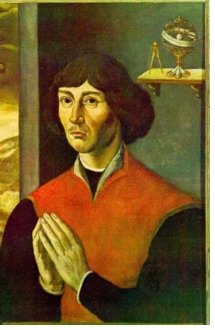 The father of Nicolaus Copernicus was a merchant, who had the means to send his son to university. Studying at the University of Krakow (Poland) Nicolaus became interested in astronomy.
The father of Nicolaus Copernicus was a merchant, who had the means to send his son to university. Studying at the University of Krakow (Poland) Nicolaus became interested in astronomy.Polish astronomer, b. 19 February 1473 (Torún, Poland), d. 24 May 1543 (Frauenberg, East Prussia; today's Frombork, Poland).
 The father of Nicolaus Copernicus was a merchant, who had the means to send his son to university. Studying at the University of Krakow (Poland) Nicolaus became interested in astronomy.
The father of Nicolaus Copernicus was a merchant, who had the means to send his son to university. Studying at the University of Krakow (Poland) Nicolaus became interested in astronomy.
When Nicolaus' uncle Lucas Waczenrode was elected bishop of Ermeland he planned for his nephew to receive lifelong financial support by becoming a canon (a paid official of the church) in Frauenburg. As there was no immediate vacancy, he sent him in 1497 to the University of Bologna, where Nicolaus studied Greek, mathematics, astronomy and the writings of Plato.
Copernicus stayed in Bologna (Italy) until 1503, returning to Poland only briefly in 1501 to formally take up his service for the cathedral and receiving a degree of Doctor of Canon Law (church law) by the University of Ferrara (Italy). He had a complete education in all fields of knowledge of the time, including mathematics, astronomy, medicine and philosophy. In Frauenburg he applied his medical skills and generally acted as a representative of the cathedral chapter.
As a private interest Copernicus continued to study the stars. The Ptolemaic system, in which the Earth is taken to be at rest in the centre of the universe and the Sun, the planets and all stars revolve around it on complicated paths of circles moving on larger circles, was no longer able to explain the observed movement of the planets. There was widespread unease about this situation; but Ptolemaic teaching had attained the status of church dogma, and questioning it could be a dangerous undertaking.
Copernicus studied the works of ancient Greek authors and discovered that the idea of an Earth that revolves around the sun had been suggested several times. He used his mathematical skills to develop an alternative to the Ptolemaic system, in which the Earth and all planets revolve around the sun. His system was aesthetically superior but not much simpler, because Copernicus still believed that planets move on perfect circles (in reality they move on ellipses).
During 1510 - 1514 Copernicus summarized his new system in De hypothesibus motuum coelestium a se constitutis commentariolus ("A commentary on the Theories of the Motions of Heavenly Objects from their Arrangements") and circulated this text among friends. He refused, however, to have his ideas published. In 1533 he presented them as a lecture to Pope Clement VII, who did not disprove, and in 1536 he formally asked for permission to publish.
It was not until 1540 that a friend was allowed to take the complete manuscript De revolutionibus orbium coelestium ("On the Revolutions of the Celestial Spheres") to Germany for publication. It was published in 1543. Tradition has it that on the last day of his life a copy of the printed work was given to Copernicus in Frauenburg.
Westman, R. S. (1995) Nicolaus Copernicus. Encyclopaedia Britannica 15th ed.
Portrait: detail from the ephitaphium in St. John Basilique in Torún, c. 1580; public domain.